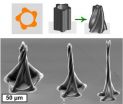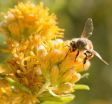(Press-News.org) ANN ARBOR, Mich.---A drug marketed to grow bone in osteoporosis patients also works to heal bone wounds in gum disease patients, a University of Michigan study suggests.
"This new approach for the treatment of periodontal disease could allow us to rebuild some of the bone that is lost due to periodontal disease, which until this point has been very difficult to achieve," said Jill Bashutski, clinical assistant professor at the U-M School of Dentistry and first author on the study. "Current treatments to re-grow bone around teeth affected with gum disease have limited success rates."
The findings are significant because gum disease is the leading cause of tooth loss in adults and is associated with a host of other health problems. Periodontal disease results in loss of teeth and can be devastating because it compromises speaking as well as eating, which can in turn contribute to poor nutrition.
The generic name of the drug is teriparatide and it is marketed by Eli Lilly and Co. under the trade name Forteo. It's a type of parathyroid hormone and the only anabolic (meaning it grows bone) osteoporosis drug approved on the market in the United States. Typically, osteoporosis drugs work by preventing bone loss.
The study, "Teriparatide and Osseous Regeneration in the Oral Cavity" appears online in the New England Journal of Medicine Oct. 16 and in the print edition Oct. 28. The study was presented Oct. 16 in Toronto at the annual meeting of the American Society for Bone and Mineral Research.
The study took place at the School of Dentistry's Michigan Center for Oral Health Research, where patients with severe chronic gum disease received the traditional treatment for gum disease, which is periodontal surgery on one-quarter of the mouth. Half of the patients took a six-week course of teriparatide by injection into the skin over the abdomen or stomach, plus calcium and vitamin D supplements, while the other half received a placebo.
After one year, researchers saw a 29 percent improvement in bone-level measurements on x-rays in the teriparatide group, versus a 3 percent improvement in the placebo group, a 10-fold increase.
"I think one really interesting aspect of this study is that even a short dosing of this drug had benefits that lasted a year," said Laurie McCauley, U-M professor and chair of periodontics and oral medicine, and principal investigator on the study.
McCauley's research lab has spent nearly two decades studying how parathyroid hormone works. Animal models suggest that it works even better in certain bone wound-healing situations, such as those that involve surgery, than in osteoporosis, which is a diminishing of the bone rather than a wound.
"There was speculation that the bone that forms in a wound like a fracture or inflammatory disease condition might be more responsive to being built back than other bone," said McCauley, who noted that this proved true in the experimental group.
McCauley said the next step is for U-M researchers to test whether the treatment could be delivered locally to target site-specific bone healing. Forteo is not FDA approved for uses other than osteoporosis, but another possible application could be to help grow bone around dental implants.
INFORMATION:
McCauley: http://www.dent.umich.edu/pom/faculty/links/LMcv
Bashutski: http://www.dent.umich.edu/pom/faculty/links/jbbio
MCOHR: http://www.dent.umich.edu/mcohr
U-M Dentistry: http://www.dent.umich.edu/
Osteoporosis drug builds bone in patients with gum disease
2010-10-20
ELSE PRESS RELEASES FROM THIS DATE:
A middle class that copes by shopping secondhand
2010-10-20
Conventional wisdom holds that people try to mimic the behavior of the next social class above their own.
Except when it comes to shopping at secondhand stores and yard sales, concludes a new study by Brigham Young University sociology students and faculty.
The study found that high-income shoppers scour the secondhand market for antiques, but everyone else is trying to stretch the family dollar.
"Middle-class shoppers were looking for furniture, some appliances, clothes, things that you could argue are necessities," said BYU sociology professor Ralph Brown. "There's ...
UT professor defines play, discovers even turtles need recess
2010-10-20
Seeing a child or a dog play is not a foreign sight. But what about a turtle or even a wasp?
Apparently, they play, too.
In fact, according to Gordon Burghardt, a psychology professor at the University of Tennessee, Knoxville, many animals -- not just dogs, cats, and monkeys -- need a little play time.
"I studied the behavior of baby and juvenile reptiles for many years and never saw anything that I thought was play. Then I had an epiphany when I saw Pigface, a Nile softshell turtle, batting around a basketball at the National Zoo in Washington, D.C. I realized ...
New clinical trial explores role of vitamin D in preventing esophageal cancer
2010-10-20
CLEVELAND – In a first-of-its-kind clinical trial, physicians at University Hospitals (UH) Case Medical Center who are Case Western Reserve University School of Medicine researchers are exploring the role of Vitamin D in preventing esophageal cancer. Principal Investigator Linda Cummings, MD, along with Amitabh Chak, MD, and Gregory Cooper, MD, from the UH Digestive Health Institute, is recruiting patients with Barrett's esophagus to measure the effects of Vitamin D on protein levels that may influence the risk of developing esophageal cancer.
"Vitamin D is being studied ...
Intricate, curving 3-D nanostructures created using capillary action forces
2010-10-20
ANN ARBOR, Mich.---Twisting spires, concentric rings, and gracefully bending petals are a few of the new three-dimensional shapes that University of Michigan engineers can make from carbon nanotubes using a new manufacturing process.
The process is called "capillary forming," and it takes advantage of capillary action, the phenomenon at work when liquids seem to defy gravity and travel up a drinking straw of their own accord.
The new miniature shapes, which are difficult if not impossible to build using any material, have the potential to harness the exceptional mechanical, ...
Gene activity in the brain depends on genetic background
2010-10-20
SEATTLE, Wash.—October 18, 2010—Researchers at the Allen Institute for Brain Science have found that the same genes have different activity patterns in the brain in individuals with different genetic backgrounds. These findings may help to explain individual differences in the effectiveness and side-effect profiles of therapeutic drugs and thus have implications for personalized medicine. The study is available in this week's online early edition of the Proceedings of the National Academy of Sciences (www.pnas.org).
In this study, the authors compared where in the brain ...
See no shape, touch no shape, hear a shape?
2010-10-20
Scientists at The Montreal Neurological Institute and Hospital – The Neuro, McGill University have discovered that our brains have the ability to determine the shape of an object simply by processing specially-coded sounds, without any visual or tactile input. Not only does this new research tell us about the plasticity of the brain and how it perceives the world around us, it also provides important new possibilities for aiding those who are blind or with impaired vision.
Shape is an inherent property of objects existing in both vision and touch but not sound. Researchers ...
Sniffing out shoe bombs: A new and simple sensor for explosive chemicals
2010-10-20
CHAMPAIGN, Ill. — University of Illinois chemists have developed a simple sensor to detect an explosive used in shoe bombs. It could lead to inexpensive, easy-to-use devices for luggage and passenger screening at airports and elsewhere.
Triacetone triperoxide (TATP) is a high-powered explosive that in recent years has been used in several bombing attempts. TATP is easy to prepare from readily available components and has been difficult to detect. It defies most standard methods of chemical sensing: It doesn't fluoresce, absorb ultraviolet light or readily ionize.
The ...
Old bees' memory fades; mirrors recall of mammals
2010-10-20
A study published Oct. 19 in the open access journal Public Library of Science (PLoS) ONE, shows that not just human memories fade. Scientists from Arizona State University and the Norwegian University of Life Sciences examined how aging impacts the ability of honey bees to find their way home.
While bees are typically impressive navigators, able to wend their way home through complex landscapes after visits to flowers far removed from their nests, the study reveals that aging impairs the bees' ability to extinguish the memory of an unsuitable nest site even after the ...
Drought may threaten much of globe within decades
2010-10-20
The United States and many other heavily populated countries face a growing threat of severe and prolonged drought in coming decades, according to results of a new study by National Center for Atmospheric Research (NCAR) scientist Aiguo Dai.
The detailed analysis concludes that warming temperatures associated with climate change will likely create increasingly dry conditions across much of the globe in the next 30 years.
The drought may reach a scale in some regions by the end of the century that has rarely, if ever, been observed in modern times.
Using an ensemble ...
Study reveals superior sedation method for children
2010-10-20
Procedural sedation and analgesia is an essential element of care for children requiring painful procedures in the emergency department. The practice of combining ketamine and propofol, two common medications used in emergency departments, has become more popular. However, until recently, it was unclear whether this practice was superior to the use of either agent alone, especially in children.
Research led by Drs. Amit Shah, Gregory Mosdossy and Michael Rieder of the Schulich School of Medicine & Dentistry at The University of Western Ontario and Lawson Health Research ...


